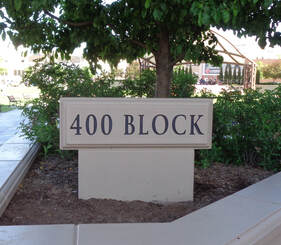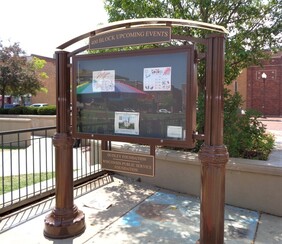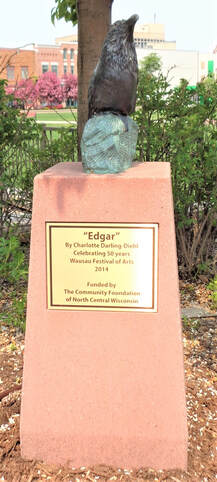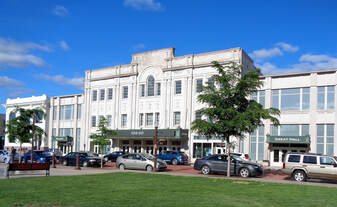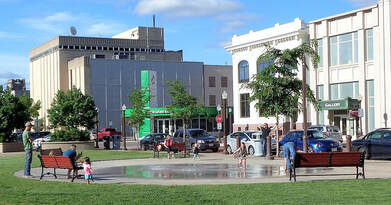Wausau
Wausau 400 BLOCK Bandshell
|
The 400 BLOCK, in the heart of Wausau, was dedicated June 20, 2011, with the bandshell prominently located at the south end of the Block. The entire block was designed by Becher Hoppe Engineers and Architects. Upon visiting the 400 BLOCK, your eye immediately is drawn to the arch fabric roof canopy of the bandshell by Tensions Structure. The canopy soars over the site - it is the largest of its kind in the Midwest with snow and wind being factored into the design. Red granite (for which Marathon County is well known) forms a curved base upon which is etched with the major donors from the community. The stage is set at a height that does not overpower the space. The ground surface slopes away from it for a distance and slopes back further from the stage to give visual lines throughout the 400 BLOCK. Cedars line the back of the stage with a center opening. Steps at the back give access to the stage area. (Information was provided by Becher Hoppe.) |
Free Concerts are held every Wednesday during the summer.
Various businesses and groups sponsor these events.
It now enjoys success in the community with many other events throughout the year:
Winterfest,
Market Place Thursdays,
Chalkfest,
Harvest Fest, and
the Holiday Parade.
Various businesses and groups sponsor these events.
It now enjoys success in the community with many other events throughout the year:
Winterfest,
Market Place Thursdays,
Chalkfest,
Harvest Fest, and
the Holiday Parade.
Construction and Grand Opening
The rich history of the 400 BLOCK begins in 1853 when the first of four Marathon County Courthouses was built. The fourth one lasted 63 years (1892 until 1955); it was built of Marathon red granite and with a six-story clock tower and the site was called Courthouse Square. In 1955 the courthouse was razed and the Square was sold for the development of three commercial buildings. The retail buildings successfully operated for 40 years, but by the mid 1990s, the same fate occurred as in many other downtowns - they were mostly vacant.
At that time, a group of citizens had a vision to make the Square back into a public space. Thus the Courthouse Square Committee was formed, a public private partnership. Of the three large commercial properties on the site, one made an unrestricted gift which in turn, helped to gain more community support. In 1997, the City Council voted to purchase the other two.
By May 2000, the City approved a consultant's recommendation to make the entire Square a public place. It was not until 2009 that a design for the block was adopted by the Council - a challenge that took nine years and many public hearings.
Becher Hoppe Engineers and Architects joined as lead design consultants in 2007, immersing themselves in all aspects of the 400 BLOCK. The bandshell design was selected from several community suggestions presented during the design development process. While not intended to dominate the site, the bandshell is a prominent feature of the 400 BLOCK.
The Council voted to allow $1,200,000 for the cost with $1,000,000 to come from private funds, and $200,000 from the City, through in-kind works. The Square Up Committee was formed and Mayor Jim Tipple appointed Joe Mella as chair to raise the funds. It was jump started with $123,000 from the balance of the Courthouse Square Fund and also by a gift from Dwight and Linda Davis of $390,000. It took less than a year to raise the remaining $487,000. Within the $1,000,000, there was a wonderful anonymous donation of $350,000 for the bandshell, which included funding for lighting, a sound system, and all other elements.
In 2012, the 400 BLOCK project was presented to the Engineering Excellence Awards of the American Council of Engineering Companies where it received a State Finalist Award. The 400 BLOCK is a testimony to what a public/private partnership can achieve. Through the entire long process, all stakeholders were involved in the decision making to make it a reality. It now enjoys success in the community with many events and concerts held throughout the year from Winterfest, Concerts on the Square, Market Place Thursdays, Chalkfest, Harvest Fest, and the Holiday Parade.
At that time, a group of citizens had a vision to make the Square back into a public space. Thus the Courthouse Square Committee was formed, a public private partnership. Of the three large commercial properties on the site, one made an unrestricted gift which in turn, helped to gain more community support. In 1997, the City Council voted to purchase the other two.
By May 2000, the City approved a consultant's recommendation to make the entire Square a public place. It was not until 2009 that a design for the block was adopted by the Council - a challenge that took nine years and many public hearings.
Becher Hoppe Engineers and Architects joined as lead design consultants in 2007, immersing themselves in all aspects of the 400 BLOCK. The bandshell design was selected from several community suggestions presented during the design development process. While not intended to dominate the site, the bandshell is a prominent feature of the 400 BLOCK.
The Council voted to allow $1,200,000 for the cost with $1,000,000 to come from private funds, and $200,000 from the City, through in-kind works. The Square Up Committee was formed and Mayor Jim Tipple appointed Joe Mella as chair to raise the funds. It was jump started with $123,000 from the balance of the Courthouse Square Fund and also by a gift from Dwight and Linda Davis of $390,000. It took less than a year to raise the remaining $487,000. Within the $1,000,000, there was a wonderful anonymous donation of $350,000 for the bandshell, which included funding for lighting, a sound system, and all other elements.
In 2012, the 400 BLOCK project was presented to the Engineering Excellence Awards of the American Council of Engineering Companies where it received a State Finalist Award. The 400 BLOCK is a testimony to what a public/private partnership can achieve. Through the entire long process, all stakeholders were involved in the decision making to make it a reality. It now enjoys success in the community with many events and concerts held throughout the year from Winterfest, Concerts on the Square, Market Place Thursdays, Chalkfest, Harvest Fest, and the Holiday Parade.
|
At the 400 BLOCK, a criss-crossing promenade intersects in the middle where a circle of bricks with donors engraved names has been laid. At the east side, there is a fountain/splash park, and used in the winter as an ice rink.
The 400 BLOCK is surrounded by many restaurants, shops, and the historic Grand Theater. |
Location |
